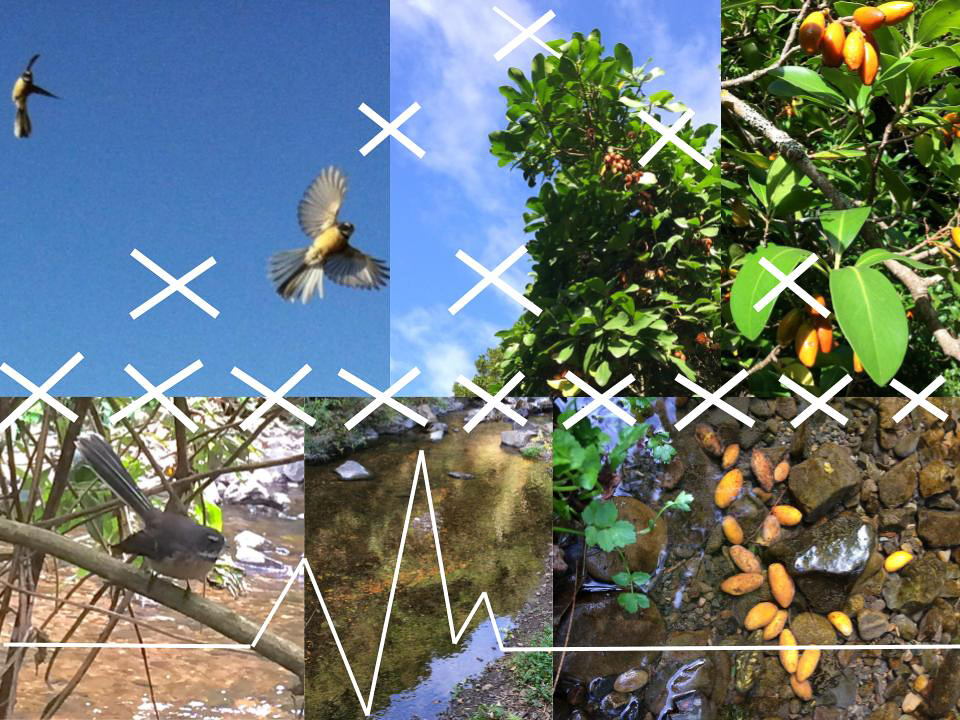
The image is a collage of photos showing the Pīwaiwaka bird and the Karaka tree. Both are considered conduits to the spirit world, to our ancestors. The x marks are stars above our heartbeat, both indicating the conversation between the physical to the metaphysical.
Arihia Latham describes the importance of taste as a life energy in rongoā, Māori medicine.
(A message to the reader.)
There are stories that have been whispered to me since I was born. I am of Papatūānuku the earth mother and Ranginui the sky father. I was born quiet, listening in the deep night. Hine Te Iwaiwa the goddess of birth blessing my arrival, Hine Nui Te Pō, the goddess of death, waiting softly in the shadows.
There is something ancient about our mouths as our first sensor. As babies, it was through taste that we first understood the sweetness of milk, the feeling of our hands, and then every single thing we came across. Through our mouths, we formed pictures of the world. Through taste, we learnt what was safe and what wasn’t. Through taste, we experienced the formative perceptions etched into memory.
The taste of something informs us of what a plant or food might do in our body. Kumara, our sweet potato, is one of the best first foods and is a medicine for restoring health. Its sweetness is calming and soothing. It is gentle to digest and builds our energy in a sustained way. Rongomātane is the deity of the kumara and of peace. The peaceful feeling in a sweet taste is something we often crave when things are out of control. It is grounding and nourishing.
Rongo brings peace through taste. Rongo is also the Māori word for our perception of the world that is not visual. How are our body and mind tuned to really perceive? Absorption of the world through our senses becomes something new, something embodied. Ka rongo tātou. Rongoā is the word for medicine. The microscopic level of listening as constituents of plants, first experienced through taste, cause a cascade of change in the body. A resonance is perceived on all levels of self.
My afterbirth was buried beside a lake underneath a karaka tree with fragrant orange fruit. The kernel is poisonous unless you know how to prepare it. A tōhunga buried this part of my mother and me, returning the placenta to the earth, whenua ki te whenua. He insisted I would be able to hear and feel and taste things that the trees could tell me. He insisted and so it was. I went back to stay with him as I was nearing the end of my childhood, painting and drawing the forest around my house and finishing my degree in health science. I asked him so many questions about plants. He answered none of them verbally.
Instead, he took me into the ngahere, the forest beside the lake, at the base of mountains and he handed me the red-tipped leaves of the Horopito plant. I sucked on a leaf and my mouth caught fire, my eyes watered and I started to see the air in front of me with different viscosity. It made me think of the goddess Mahuika and how each of her fingernails was a flame. How she held the power of fire and threw her final flame to the trees to hide its potential there.
The tōhunga asked me, “What is the plant telling you through its taste?”
I said carefully “Like fire, it can clear away the things that we don’t need. It can generate heat in our puku, our belly.” He nodded and smiled and kept walking.
“But.. is that right?” I queried behind him as he walked on.
“Ask the plant”, he commented back in te reo Māori.
Now I live on land that is known as Paekawakawa. The land of the kawakawa plant or perhaps also of the bitter wind. Kawa means bitter or sour and when the wind is flung at us here, it is from Antarctica. This is like my ancestor Hine Punui a Toka, the goddess of the southern wind. I think of how she was perhaps named bitter out of turn and how often we confuse the stimulating bitter or sour tastes or experiences as something unpleasant when in fact it brings a newness to things that are stuck.
The leaves of the Macropiper excelsum plant Kawakawa are from the pepper family, which includes Kava.
Their bitter taste induces salivation, which in turn increases hydrochloric acid and bile flow. It is warming and soothing. The fruit has a sweet spiciness to it and the tea made from leaves has a minty sweetness to it too before turning bitter on steeping. This bitter-sweetness is part of the story of this plant. Its heart-shaped leaves were sent to heal Papatūānuku’s broken heart, to bring about life again. The separation of the earth and sky too was bittersweet. The couple grieves with their tears of rain and groundwater floods. The sweetness comes from the life that gets to exist as a result. Kawakawa’s leaves numb your mouth on eating them. They soothe some of the pain, while they stimulate the body into action. Blood flow, digestion and inflammation are all regulated while this plant mends our numbed hearts softly.
If you sit a perfectly packaged new spear of Koromiko Hebe veronica on your tongue, it will start to dry the saliva from your mouth, such is its astringency. This taste is not pleasant but is the most toning and regulating when our body is losing fluid. It’s one of the best digestive restorers. The name koromiko refers to the spiralling shape of the white cone of flowers. The spiral eternally solves itself and in a way, as the body moves to spiral out of balance, with koromiko it will come back to the centre in time.
The salty taste is known to bring balance to other tastes and to restore water in our cells. It is in our tears, our sweat, and the ocean. Karengo is our native seaweed and its saltiness brings with it iodine, iron and folate. It is anti-inflammatory and regulates the immune system and thyroid gland. It is the child of Tangaroa, our ocean atua, the first love of Papatūānuku the earth in the story of my ancestors. The salty taste enhances other tastes and as a medicine, seaweed builds up those that are weakened and exhausted. The tides of our energy can suck out long and so we often need support to rise back to our own fullness.
Taste is something that leaves an imprint, that creates a movement in our body. It has its own oro or resonance. This alteration in resonance impacts our mauri, our life force. It also translates into other sensory experiences such as vision and sound. Taste is like a template that transforms mood, that instigates action. Taste, and eating as a ritual is something that shifts the tapu, the sacred state. It normalises things and brings us into our bodies and firmly on the side of the living. On seeing a baby tasting sweet milk for the first time Hine Nui Te Pō the goddess of death retreats. In old age, as our body refuses to eat anymore, she returns.
Taste as an awakening, as an embodiment, is something that the process of creating requires. Artistic inspiration is not unlike the sensory experience of taste. It can clear space to create, or it can ground us in our bodies to sustain our creative vision. The medicine of plants can change our chemical balance and neural responses. It can affect the patterning in our cells. The resonance of the trees can be transcribed by the art that we produce as a result. The spiral of response from one taste can lead us on an experiential pathway that stimulates our hunger for life. Experiencing the world through taste brings us into the place of perception and everyday ritual. Watching the body respond to the medicine of taste and the shapes and stories that those remedies create is our rongoā; the art of experience.
This article is supported by Creative New Zealand.
About Arihia Latham
 Arihia Latham is a Kāi Tahu, Kāti Mamoe and Waitaha Māori writer, sustainability advisor and rongoā practitioner living in Te Whanganui a Tara, Aotearoa. She has performed her poetry at many festivals and her written work has been widely anthologised. Her debut collection Birdspeak is out in 2023 through Anahera Press.
Arihia Latham is a Kāi Tahu, Kāti Mamoe and Waitaha Māori writer, sustainability advisor and rongoā practitioner living in Te Whanganui a Tara, Aotearoa. She has performed her poetry at many festivals and her written work has been widely anthologised. Her debut collection Birdspeak is out in 2023 through Anahera Press.
A rongoā practitioner is someone that offers traditional Māori health practices to others. For some, this includes hands-on practices of mirimiri and romiromi which are massage and energy-clearing practices. Wairākau are plant medicines usually steeped in water or fat to treat disease and restore wellbeing- hauora. All have careful tikanga-guidelines such as karakia and timing.

